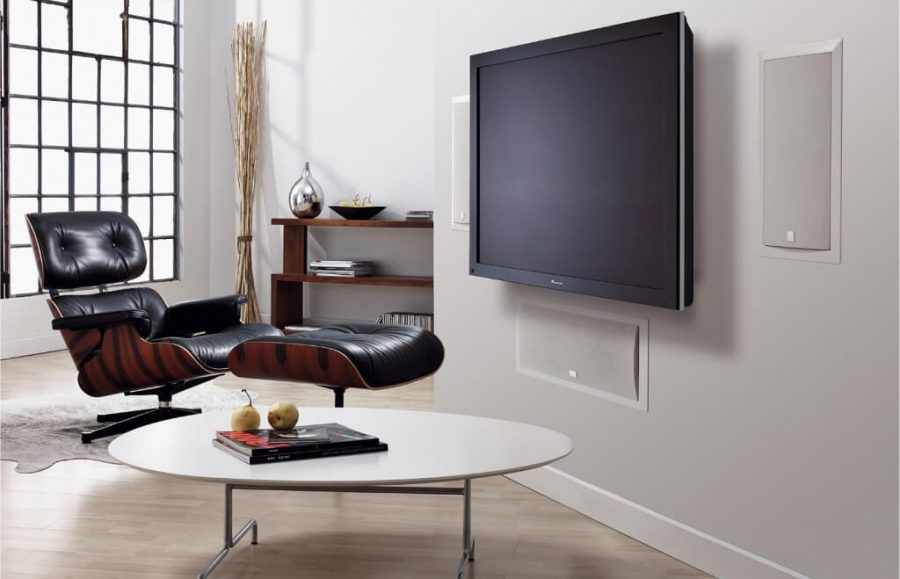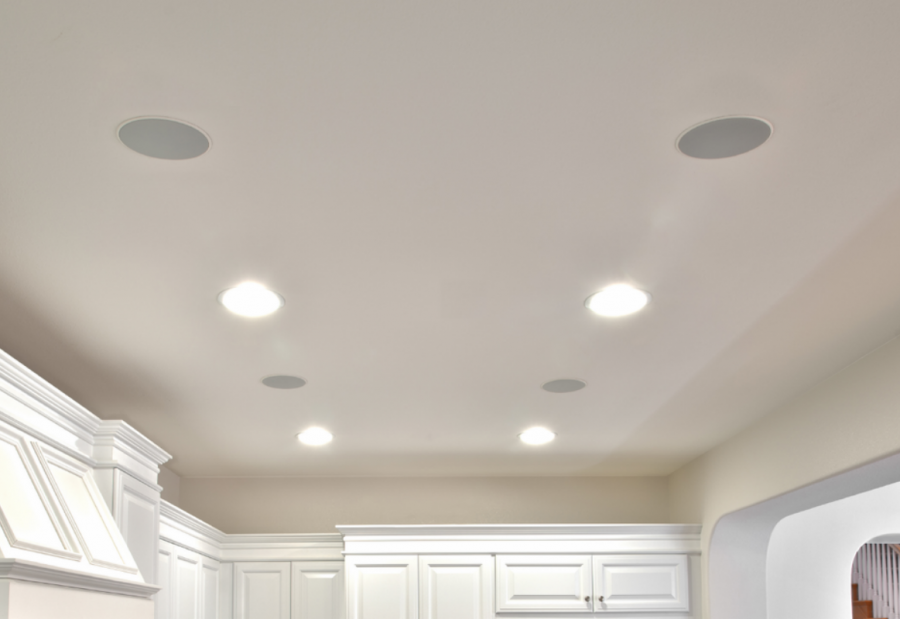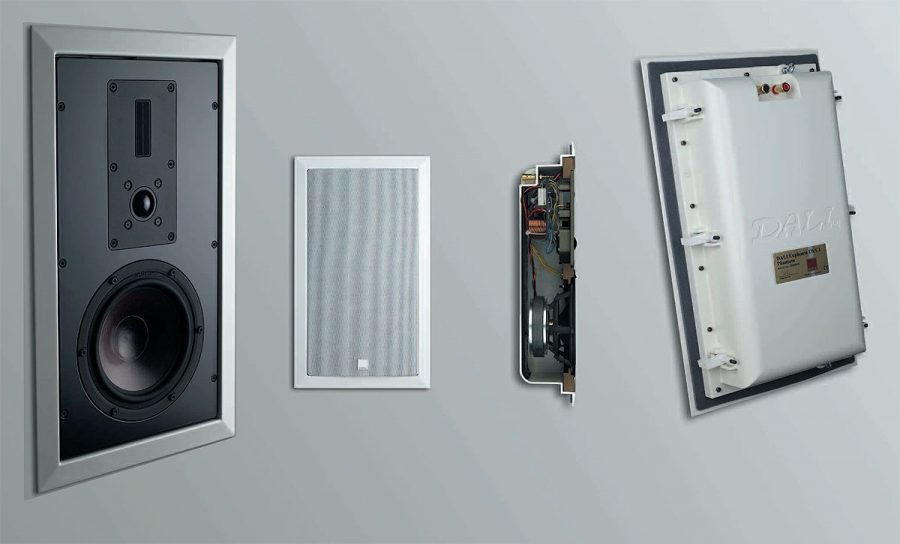Functional built-in acoustics allows you to create the perfect atmosphere for watching a movie, listening to music or playing games. It does not occupy space in the room and fits perfectly into any design. Today we will discuss what types of home and commercial acoustics exist, and what you should pay attention to when choosing devices.

Content
What is embedded acoustics
Built-in acoustics for the home is a set of speakers, subwoofers, control equipment and sound amplifiers, which are installed indoors using the technology of flush mounting. The best places for embedding acoustics are walls, ceilings and oversized furniture.

There are broadband and multi-band systems that differ in the number of sound emitters. In the first version, only one emitter is used, and in the second - several speakers playing in different frequency bands at once. Also, devices can be active or passive, depending on the availability of a built-in amplifier.
Embedded Advantages
Not all apartments have extra space to accommodate large floor-mounted speaker systems. This is especially true of home theaters, which, as a rule, include several interconnected separate modules at once. In addition, most owners prefer not to pile up the interior with appliances.
Home acoustics takes up little space and does not stand out from the overall design of the apartment. It is less susceptible to external damage, since most of the body is recessed in the wall or hidden on the ceiling. Placement of embedded systems takes into account the characteristics of the room. The main advantages of such acoustics:
- The most juicy and clear sound, without distortion and extraneous noise;
- Installation takes into account the characteristics of the room, so the sound is much more voluminous and better perceived by the audience;
- Uniform sound due to the use of several modules and emitters at once;
- Built-in acoustics do not stand out from the interior of the room;
- It is more resistant to external damage than freestanding devices;
- It is better suited for public places, such as restaurants, cafes, bars, sports complexes, etc., because it has a hidden building.
Kinds
Regardless of the number of sound emitters and built-in amplifiers, speakers are divided into wall and ceiling. Ceiling devices are more invisible in the interior of the room, as they are light in weight and compact in body. Wall systems are larger and heavier, they can be seen in any circumstances. More about the types of built-in acoustics:
In the wall
The built-in wall-mounted speakers (In Wall) are predominantly rectangular or square. They are used in high-tech home theaters as multimedia speakers. Multiband or multiband embedded systems with a central emitter location can be used both as a loudspeaker and as a speaker for front channels.
Such devices have a fairly large case size and heavy weight, but they are distinguished by wide functionality and affordable cost (it depends on the quality of the amplifier, speaker, control system, etc.). They can be used in large rooms even in the absence of additional playback modules - there will be enough power.This category of acoustics can also include sound panels and soundbars, which are often installed over widescreen screens. They are considered as an alternative to conventional stationary speakers.
Benefits:
- With a good amplifier, wall-mounted speakers produce clear and surround sound. This allows you to achieve maximum immersion in a film or musical composition;
- They are easier to install than other embedded devices;
- Loud enough to fill a large room with sound.
Disadvantages:
- More noticeable in the interior than ceiling systems;
- Heavy body;
- Sound is not distributed so evenly, as waves bounce off obstacles.
In the ceiling

Ceiling systems (InCell) are round in shape and small in size. This arrangement is considered more successful than wall or standard (floor), because sound waves are less reflected from obstacles. The sound is evenly distributed in the room and is felt deeper than in a different arrangement. Even so, it is better to entrust the installation of equipment to specialists, because only they can develop a successful project for installation in the ceiling.
Ceiling speakers are well protected from external damage. It is suitable for commercial premises (clubs, shops, restaurants, bars, sports centers, etc.) because it is located outside the visitors' access area and does not stand out from the interior. You can also save by choosing a completely open system.
Benefits:
- Lightweight housing that allows you to integrate acoustics into drywall and suspended ceilings;
- The sound is evenly distributed in the room, because it does not encounter obstacles such as columns, furniture or interior items;
- The external speaker is invisible when built into the ceiling.
Disadvantages:
- Installation is more complicated than wall mounted devices;
- Higher cost.
It is difficult to say which location is better - ceiling or wall. For commercial premises, such as restaurants, clubs or boutiques, it is better to install acoustics on the ceiling, because It is more inconspicuous and resistant to external damage. For home use, wall-mounted equipment is suitable.
Manufacturers
Built-in speakers are a long-term and quite expensive solution, so it is important to buy equipment only from trusted brands. This ensures the availability of good service and quality assembly. It is much more profitable to spend money once than later to dismantle the acoustics due to breakage or poor sound. Companies such as Artison, BG Radia, Wisdom Audio, Sonance, Solus Audio, Klipsch, Jamo, Polk Audio, B&W (Bowers & Wilkins), Audeze, Heco, Cerwin Vega, Tannoy, Yamaha are considered the best manufacturers of audio equipment. They have long existed in the market, have high quality service, and provide a long warranty period for their equipment.
How to choose a built-in speaker system
When choosing acoustics, it is important to pay attention to the quality of materials and basic technical characteristics, such as power, sensitivity, resistance, frequency range, number of bands, etc. Accordingly, the better the named parameters, the higher the cost of the device. Also consider the usability and the ability to remotely control the system (via bluetooth or radio signal). More on important features:
Number of stripes
An acoustic system can have from one to seven frequency bands, which are responsible for the transmission quality and sound volume. The most optimal and inexpensive option is two-way systems, where one band is responsible for reproducing and processing the lower frequency range, and the second for the middle and upper ones. However, it is better to choose devices with three or more bands, which, despite the increased cost, produce a better and more detailed sound. In such acoustics, one band is responsible for the lower frequencies, the second for the middle, and the third for the high.
But if you do not have a pronounced ear for music, and you choose a system for a home theater or TV, the difference between two-way and three-way systems will be almost imperceptible. In this case, do not overpay for more advanced acoustics. Broadband and dual-band devices are well suited for occasional home use.
Device power
Power is responsible for the "strength" of the sound and the durability of the device. The main condition for any acoustics is that the power should be the same as that of the amplifier. If the indicators are higher, the system can quickly fail due to overvoltage. In a standard room with an area of up to 18 square meters, it is better to install acoustics with a power of 70-80 W, if the room is an average of 30 square meters - 100 W. In rooms or buildings of more than 30 squares, devices with a maximum power of 150 watts should be built in.
frequency range
The frequency spectrum indicated in the characteristics does not always affect the quality of reproduction. A more significant indicator is the amplitude-frequency characteristic, but manufacturers rarely provide it. The entire range perceived by the human ear can be divided into three levels - low, medium and high frequencies. Low ones are responsible for bass, medium ones are for vocals, and high ones are for depth and volume. For a home theater or a small media center, acoustics with a range from 100 to 20,000 Hz will be enough, for playing music compositions it is better to take devices with a spectrum from 20 to 35,000 Hz. The sound quality depends not only on the characteristics, but also on personal perception. Therefore, it is better to listen to acoustics on your own before buying.
Sensitivity
Sensitivity is the playback volume at a distance of 1 meter from the speaker. It is indicated in decibels. The higher the sensitivity parameters, the louder the acoustics will play. For example, indicators from 84 to 88 dB mean low volume, from 89 to 92 dB mean, and 94 to 110 dB mean high. When choosing a sensitive device, make sure that the sound quality at a high volume level does not deteriorate. Cheap acoustics often produce extraneous noise or wheezing.
Impedance
Impedance is an indicator responsible for the resistance of a device to alternating current. It is important when pairing speakers with an external amplifier. Be sure to make sure that the impedance of the amplifier and emitter is at the same level, otherwise the sound will be distorted.
All of these characteristics in one way or another affect the sound quality. If you plan to use the system for games and movies, then you can purchase an inexpensive device. The main thing is clarity of playback and sufficient volume. But if you often listen to music or choose acoustics for a club, it is better not to save and buy a multi-band system with a wide frequency range. Also pay attention to case materials, if available. It is better to buy a system of wood or MDF, as they have good acoustic properties.
Installation
Before installing the acoustics, it is necessary to draw up a project that will take into account the characteristics of the room and the characteristics of the system. Sound quality largely depends on the position of the device. The optimal mounting method is considered to be one in which a drywall sheet is inserted between the outer flange and the inner tabs. To install the system, it is necessary to cut a sheet of drywall (patterns are usually supplied) and tighten the tabs with a special screwdriver through the screws that are located on the front of the acoustics. And then place the protective grille on the speaker of the speaker. For installation, both single and double sheets of drywall are suitable.

Nevertheless, manufacturers do not recommend installing acoustics on their own because of the risk of improper installation or damage to the device. It is better to call specialists who will do everything right, taking into account the characteristics of the apartment or building.
To summarize
Built-in acoustics in the apartment is a good solution for those who do not want to spoil the interior of the room or occupy the space with appliances. It is more resistant to external damage than freestanding speakers, and has a better sound. When choosing, it is worth considering the technical characteristics of the device and the location in the apartment.